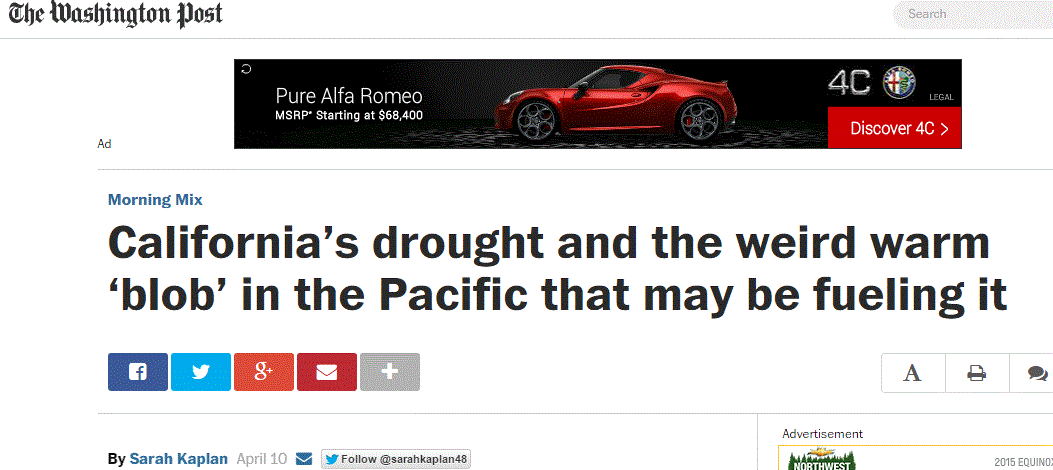During the past few days, an unfortunate example occurred regarding the warm water pool that formed over a year ago in the middle of the north Pacific, a.k.a., the blob. Let me show how this communication failure occurred, with various media outlets messed things up in various ways.
The stimulant for the nationwide coverage of the Blob was a very nice paper published by Nick Bond (UW scientist and State Climatologist), Meghan Cronin, Howard Freeland, and Nathan Mantua in Geophysical Research Letters.
This publication described the origin of the Blob, showing that it was the result of persistent ridging (high pressure) over the Pacific. The high pressure, and associated light winds, resulted in less vertical mixing of the upper layer of the ocean; with less mixing of subsurface cold water to the surface. Furthermore, the high pressure reduced horizontal movement of colder water from the north. Straightforward and convincing work.
The UW News and Information Office decided to spotlight this work in a press release, one that also
talked about a paper by Professor Dennis Hartmann: Pacific sea surface temperature and the
winter of 2014. This is another excellent paper and makes a convincing case that anomalous high
pressure in the eastern Pacific and low pressure (troughing) in the eastern U.S. (which brought cold air to the eastern U.S.) was the result of warm, water in the subtropics (NOT THE BLOB).
Unfortunately, the UW press release misrepresented the facts. Clearly, the writer did not appreciate that the two papers were discussing two different areas of warm water (the blob in the midlatitudes and a second pool of high surface temperatures in the subtropics). The title of the release was unclear (did linked indicated a cause or just a correlation?) and the first few paragraphs were explicitly wrong, suggesting that the "warm blob" was causing "weird" weather across the U.S.
Let me be explicit what these papers DID say. Dennis Hartmann's paper uses models to indicate that persistent warm water in the subtropics caused an anomalous "wave train" that altered the circulation over the eastern Pacific and North America, with high pressure over the eastern Pacific and troughing over the eastern U.S. The Bond et al. paper showed how the anomalous high pressure produced the midlatitude warm water blob.
The inaccurate press release then led to a media frenzy, with the story going viral. And unfortunately, many of the media got it wrong.
There were two failure modes. In one, the headline was wrong, but the internal story was correct. Such a failure was found in the Seattle Times article (see below). The text was written by Sandi Doughton, an excellent and careful science writer, while the headline was written by Seattle Times editorial staff. Inaccurate, hyped headlines are common in the Seattle Times. I can't tell you how many times exasperated reporters have complained to me about it.
In the second failure mode, the story itself was essentially flawed, with most claiming that the Blob off of western North America was the cause of the anomalous circulation (big ridge over West Coast, trough over the eastern U.S.). (The truth: the Blob was the RESULT of the anomalous circulations.) That the Blob CAUSED the California drought or the cold wave in the eastern U.S. These deceptive stories were found in major outlets around the country, including the Washington Post, NBC News, and others.
 |
| --------- |
-----
-------
-------
Take a look at a Weather Channel "science" page found here Its lead sentence say is all wrong:
Scientists say a mass of warm water off the U.S. West Coast is to blame for the bizarre weather affecting the country.
I could give you two dozen examples of essentially wrong stories about the Blob in major American news outlets during the past few days. And this is only one story...many other stories are similarly confused or hyped.
How many ways can you say DEPRESSING? Nearly every science story I have an intimate knowledge about has major errors.
Why is this happening? I can offer several reasons:
How many ways can you say DEPRESSING? Nearly every science story I have an intimate knowledge about has major errors.
Why is this happening? I can offer several reasons:
- University (and government) PR offices are desperate to secure media attention (get lots of "clicks") and are willing to hype stories to get it. PR folks without science backgrounds often have inadequate time to get stories right..
- Media outlets have hollowed out their science reporting staffs.
- Reporters are writing stories without reading the papers they are supposedly describing. Often they simply repeat or repackage (without checking) the press releases of universities and government agencies.
- The war for clicks (and the ad revenue the results from them) has encouraged exaggerated headlines.



















No comments:
Post a Comment